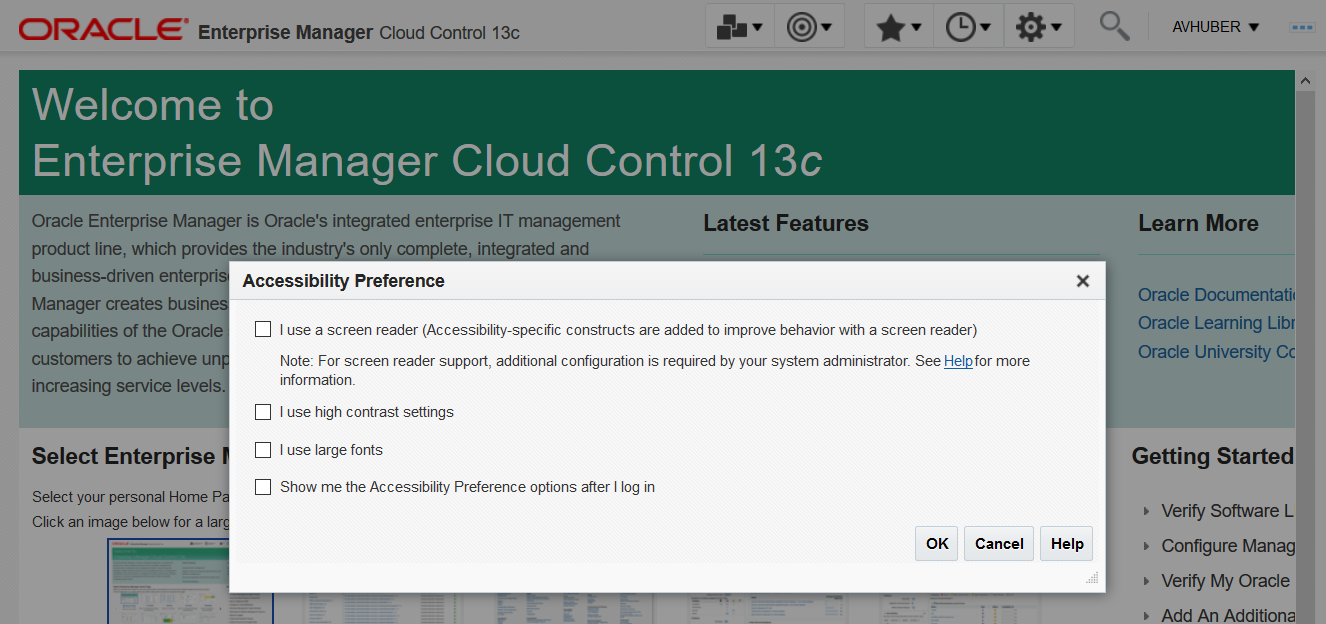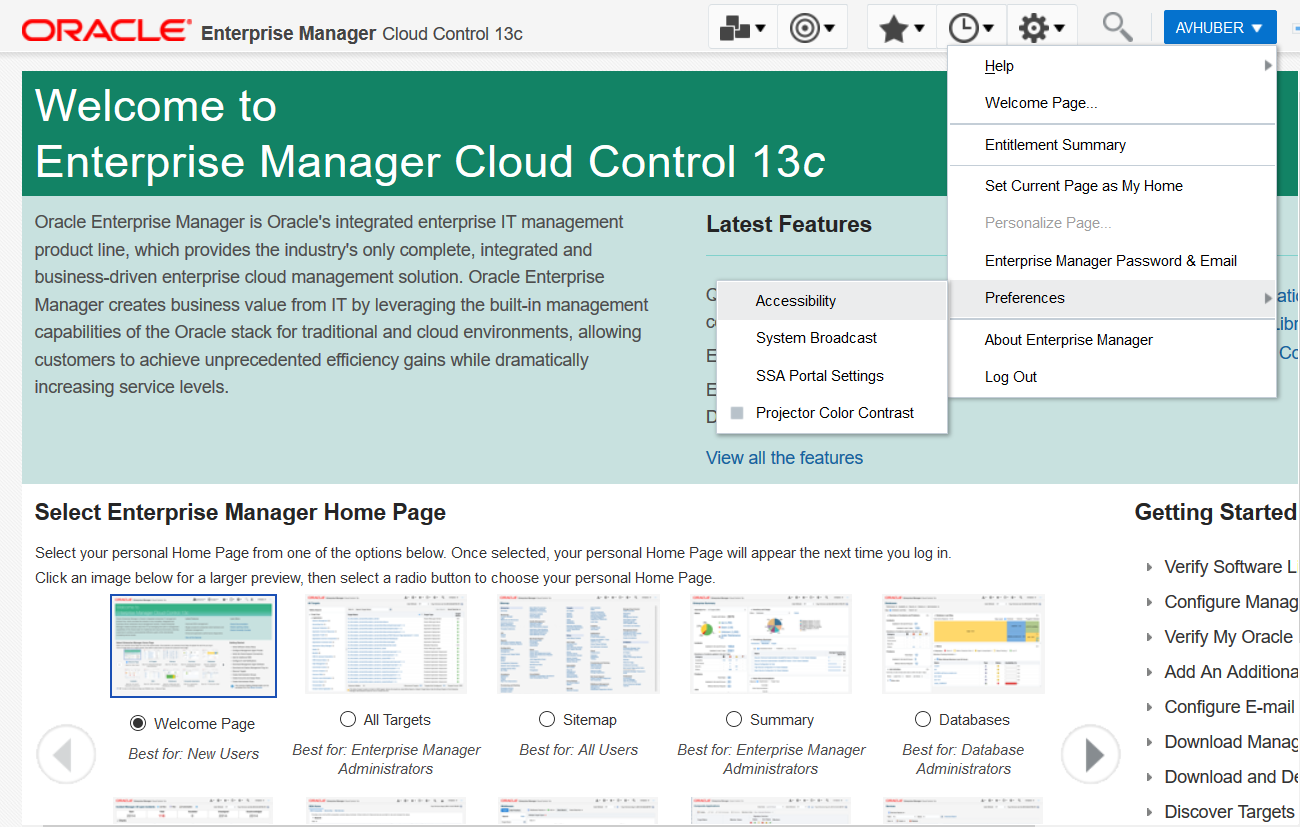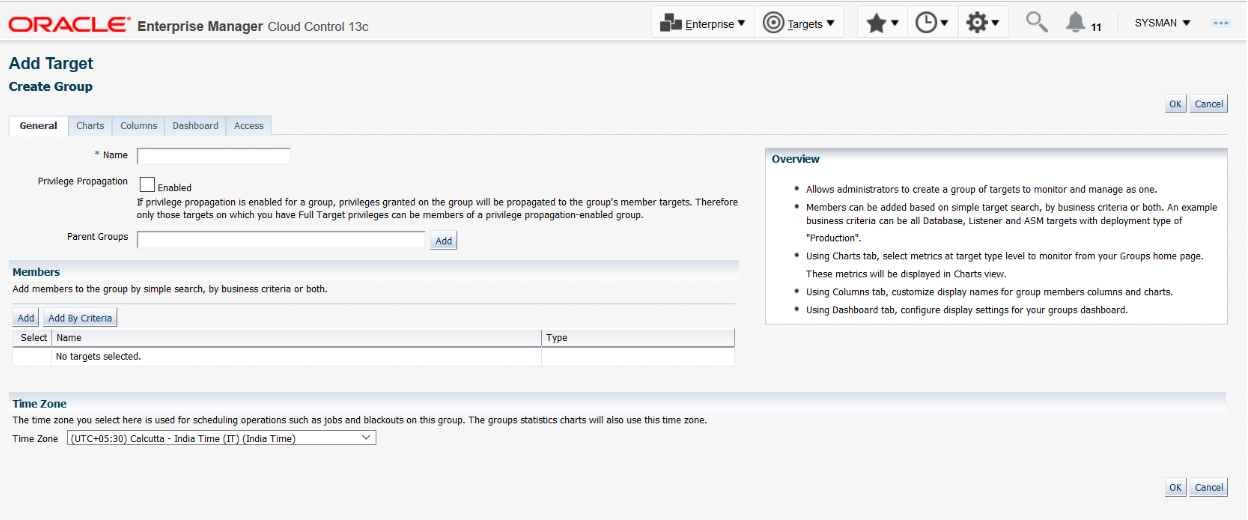F Enabling the Enterprise Manager Accessibility Features
As part of the effort to make Oracle products, services, and supporting documentation accessible and usable to the disabled community, Enterprise Manager offers several features that make management data available to users of assistive technology and individuals with disabilities in general. Enterprise Manager provides the following accessibility modes:
Enterprise Manager administrators can also navigate through the console with a keyboard alone – using common keyboard commands.
Note:
If Screen Reader support is enabled, then all pages related to Refresh Process Status are not refreshed automatically because Partial Page Rendering (PPR) is turned off. This is an expected behavior.
Enabling Enterprise Manager Accessibility Mode
-
I use a screen reader: Generate ADF Faces components that are optimized for use with screen readers.
-
I use high contrast: Generate high-contrast–friendly visual content.
-
I use large fonts: Generate browser-zoom–friendly content
-
Show me the Accessibility Preference options after I log in: Show the accessibility options after sign-in.

Note:
If you did not choose your accessibility preferences in your first login to the Cloud Control console, you can still specify your preferences at any point later by navigating to the <user_name> menu, selecting Preferences and then selecting Accessibility.
Enabling Screen Reader Mode
There are numerous pages of monitoring and management data in the Enterprise Manager Cloud Control console. Different technologies are used for implementing these pages – for example, many pages rely upon Oracle Application Development Framework (ADF), while others depend upon User Interface XML (UIX). These underlying technologies require different setup for enabling screen reader mode. Enabling screen reader mode for pages implemented with ADF requires only the “I use a screen reader” option to be selected in a user’s accessibility preferences. However, pages implemented with UIX require additional steps to be screen reader enabled.
Enabling Screen Reader Mode for UIX Pages
Some user interface, like in Oracle Application Development Framework (ADF) or in User Interface XML (UIX), in Enterprise Manager console is implemented differently and hence, requires additional configuration to support certain accessibility modes. For example, for UI implemented with UIX, additional manual configuration is needed for screen reader mode.
To enable screen reader mode for UIX pages, do the following:
Note:
UIX accessibility mode is a product-wide setting. You will have to restart the Enterprise Manager Management Service for this setting to take effect.
Note:
In the uix-config.xml file, enable-auto-table-ctrl-labels is set to true. This enables tool tip boxes containing labels to appear when you hover your cursor over UI elements such as checkboxes and radio buttons in tables. To disable this function, change the setting to false.
Enabling Text Descriptions for Charts for UIX Pages
Throughout the Enterprise Manager Cloud Control console, charts are used to display performance data. For most users, these charts provide a valuable graphical view of the data that can reveal trends and help identify minimum and maximum values for performance metrics. However, charts do not convey information in a manner that can be read by a screen reader. To remedy this problem, you can configure Enterprise Manager to provide a complete textual representation of each performance chart. By default, support for the textual representation of charts is disabled. When textual description for charts is enabled, Enterprise Manager displays a small icon for each chart that can be used as a drill-down link to the textual representation.
To configure web.xml file, follow these steps:
Verifying That Screen Reader Support Is Enabled
To verify if the Screen Reader support is enabled for ADF pages, follow these steps:
-
On the Cloud Control home page, from the <user_name> menu, select About Enterprise Manager.
-
In the About Enterprise Manager dialog box, ensure that Accessibility Preference - Screen Reader Support is set to Enabled.
-
If Accessibility Preference - Screen Reader Support is set to Disabled, follow the steps listed in Enabling the Enterprise Manager Accessibility Features.
To verify whether Screen Reader support has been enabled for UIX pages, follow these steps:
Enterprise Manager Cloud Control Keyboard Navigation
This section describes the keyboard navigation in Enterprise Manager Cloud Control Console.
Much of the keyboard navigation is the same whether or not you use screen reader mode.
Generally, you use the following keys to navigate:
-
Tab key: Move to the next control, such as a dynamic target menu, navigation tree, content pane, or tab in a page. Tab traverses the page left to right, top to bottom. Use Shift +Tab to move to the previous control.
-
Up and Down Arrow keys: Move to the previous or next item in the navigation tree, menu, or table. Down Arrow also opens a menu.
-
Left and Right Arrow keys: Collapse and expand an item in the navigation tree or a submenu.
-
Esc: Close a menu.
-
Spacebar: Activate a control. For example, in a check box, spacebar toggles the state, checking or unchecking the box. On a link, spacebar navigates to the target of the link.
-
Enter: Activate a button.
Table F-1 shows some common tasks and the keyboard navigation used.
Table F-1 Keyboard Navigation for Common Tasks
| Task | Navigation |
|---|---|
|
Move to next control, such as navigation tree or menu |
Tab |
|
Move to previous control, such as navigation tree or menu |
Shift+Tab |
|
Move to navigation pane |
Tab until navigation tree has input focus |
|
Move down the navigation tree |
Down Arrow |
|
Move up the navigation tree |
Up Arrow |
|
Expand a folder |
Right Arrow |
|
Collapse a folder |
Left Arrow |
|
Open a menu |
Down Arrow |
|
Move to the next item in a menu |
Down Arrow |
|
Move to the previous item in a menu |
Up Arrow |
|
Select a menu item |
Enter |
|
Open a submenu |
Right Arrow |
|
Close a submenu |
Left Arrow |
|
Move out of a menu |
Esc |
|
Activate a button |
Enter |
|
Open a tab in a content pane |
Tab to the content pane, Tab to the tab to get input focus, then Enter to select the tab |
|
Select an item, such as Message type in Log Messages screen |
Spacebar |
|
Select a row in a table |
Tab to the header of the table, then Down Arrow to move to a row |
|
Select a cell in a table |
Tab to the header of the table, then Tab until you reach the cell you want to select, then Enter |
